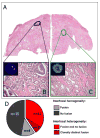TMPRSS2-ERG fusion heterogeneity in multifocal prostate cancer: clinical and biologic implications
- PMID: 17991527
- PMCID: PMC3198826
- DOI: 10.1016/j.urology.2007.08.032
TMPRSS2-ERG fusion heterogeneity in multifocal prostate cancer: clinical and biologic implications
Abstract
Objectives: To characterize the clonality of TMPRSS2-ERG fusion in multifocal prostate cancer.
Methods: From 80 consecutive radical prostatectomy specimens, we identified 32 cases with multiple spatially separate tumors. In each case, we assessed two to three tumor foci for TMPRSS2-ERG fusion using an ERG break-apart interphase fluorescence in situ hybridization assay.
Results: Individual tumor foci showed homogeneity for fusion status (intrafocal clonal homogeneity). In 19 (59%) of the 32 cases, all foci within a case had the same fusion status (interfocal homogeneity). In 15 (80%) of the 19 cases, no foci had fusion, and in 4 (20%), all foci had fusion. Of the 32 cases, 13 (41%) demonstrated heterogeneity for fusion status within a case (interfocal clonal heterogeneity).
Conclusions: In this study, we have demonstrated interfocal heterogeneity and intrafocal homogeneity for TMPRSS2-ERG fusion in prostate cancer with multiple tumors. These findings support the multiclonal nature of prostate cancer with clinical implications for needle biopsy strategies and the development of urine-based screening tests.
Figures

References
-
- Tomlins SA, Rhodes DR, Perner S, et al. Recurrent fusion of TMPRSS2 and ETS transcription factor genes in prostate cancer. Science. 2005;310:644–648. - PubMed
-
- Mehra R, Tomlins SA, Shen R, et al. Comprehensive assessment of TMPRSS2 and ETS family gene aberrations in clinically localized prostate cancer. Mod Pathol. 2007;20:538–544. - PubMed
-
- Perner S, Demichelis F, Beroukhim R, et al. TMPRSS2:ERG Fusion-Associated Deletions Provide Insight into the Heterogeneity of Prostate Cancer. Cancer Res. 2006;66:8337–8341. - PubMed
-
- Perner S, Mosquera JM, Demichelis F, et al. TMPRSS2-ERG Fusion Prostate Cancer: an early molecular event associated with invasion. Am J Surg Pathol. 2007 in press. - PubMed
-
- Demichelis F, Fall K, Perner S, et al. TMPRSS2:ERG gene fusion associated with lethal prostate cancer in a watchful waiting cohort. Oncogene. 2007 - PubMed
Publication types
MeSH terms
Substances
Grants and funding
LinkOut - more resources
Full Text Sources
Other Literature Sources
Medical

